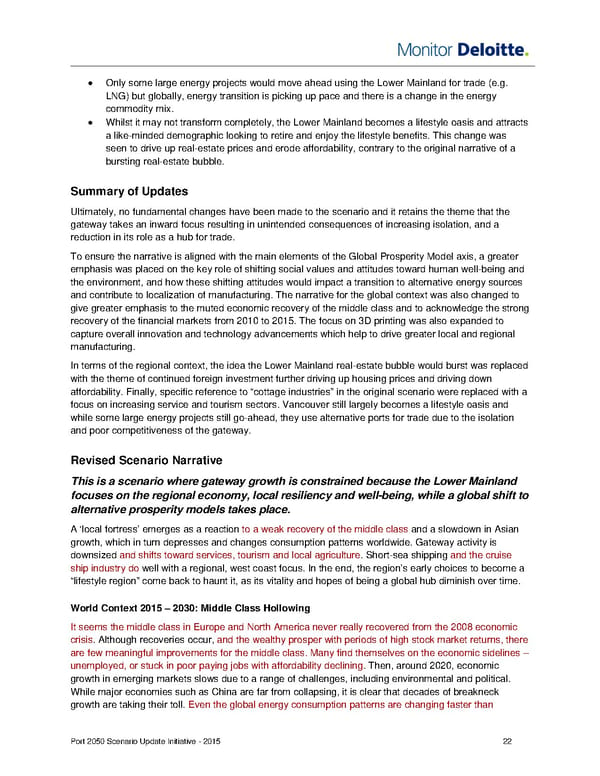• Only some large energy projects would move ahead using the Lower Mainland for trade (e.g. LNG) but globally, energy transition is picking up pace and there is a change in the energy commodity mix. • Whilst it may not transform completely, the Lower Mainland becomes a lifestyle oasis and attracts a like-minded demographic looking to retire and enjoy the lifestyle benefits. This change was seen to drive up real-estate prices and erode affordability, contrary to the original narrative of a bursting real-estate bubble. Summary of Updates Ultimately, no fundamental changes have been made to the scenario and it retains the theme that the gateway takes an inward focus resulting in unintended consequences of increasing isolation, and a reduction in its role as a hub for trade. To ensure the narrative is aligned with the main elements of the Global Prosperity Model axis, a greater emphasis was placed on the key role of shifting social values and attitudes toward human well-being and the environment, and how these shifting attitudes would impact a transition to alternative energy sources and contribute to localization of manufacturing. The narrative for the global context was also changed to give greater emphasis to the muted economic recovery of the middle class and to acknowledge the strong recovery of the financial markets from 2010 to 2015. The focus on 3D printing was also expanded to capture overall innovation and technology advancements which help to drive greater local and regional manufacturing. In terms of the regional context, the idea the Lower Mainland real-estate bubble would burst was replaced with the theme of continued foreign investment further driving up housing prices and driving down affordability. Finally, specific reference to “cottage industries” in the original scenario were replaced with a focus on increasing service and tourism sectors. Vancouver still largely becomes a lifestyle oasis and while some large energy projects still go-ahead, they use alternative ports for trade due to the isolation and poor competitiveness of the gateway. Revised Scenario Narrative This is a scenario where gateway growth is constrained because the Lower Mainland focuses on the regional economy, local resiliency and well-being, while a global shift to alternative prosperity models takes place. A ‘local fortress’ emerges as a reaction to a weak recovery of the middle class and a slowdown in Asian growth, which in turn depresses and changes consumption patterns worldwide. Gateway activity is downsized and shifts toward services, tourism and local agriculture. Short-sea shipping and the cruise ship industry do well with a regional, west coast focus. In the end, the region’s early choices to become a “lifestyle region” come back to haunt it, as its vitality and hopes of being a global hub diminish over time. World Context 2015 – 2030: Middle Class Hollowing It seems the middle class in Europe and North America never really recovered from the 2008 economic crisis. Although recoveries occur, and the wealthy prosper with periods of high stock market returns, there are few meaningful improvements for the middle class. Many find themselves on the economic sidelines – unemployed, or stuck in poor paying jobs with affordability declining. Then, around 2020, economic growth in emerging markets slows due to a range of challenges, including environmental and political. While major economies such as China are far from collapsing, it is clear that decades of breakneck growth are taking their toll. Even the global energy consumption patterns are changing faster than Port 2050 Scenario Update Initiative - 2015 22
 Monitor Deloitte - Final Report Page 23 Page 25
Monitor Deloitte - Final Report Page 23 Page 25